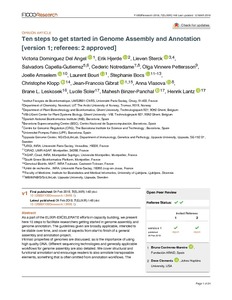Mostra el registre d'ítem simple
Ten steps to get started in Genome Assembly and Annotation
| dc.contributor.author | Dominguez del Angel, Victoria |
| dc.contributor.author | Hjerde, Erik |
| dc.contributor.author | Sterck, Lieven |
| dc.contributor.author | Capella-Gutierrez, Salvador |
| dc.contributor.author | Notredame, Cederic |
| dc.contributor.author | Vinnere Pettersson, Olga |
| dc.contributor.author | Amselem, Joelle |
| dc.contributor.author | Bouri, Laurent |
| dc.contributor.author | Bocs, Stephanie |
| dc.contributor.author | Klopp, Christophe |
| dc.contributor.author | Gibrat, Jean-Francois |
| dc.contributor.author | Vlasova, Anna |
| dc.contributor.author | Leskosek, Brane L. |
| dc.contributor.author | Soler, Lucile |
| dc.contributor.author | Binzer-Panchal, Mahesh |
| dc.contributor.author | Lantz, Henrik |
| dc.contributor.other | Barcelona Supercomputing Center |
| dc.date.accessioned | 2018-04-05T10:42:50Z |
| dc.date.available | 2018-04-05T10:42:50Z |
| dc.date.issued | 2018-02-05 |
| dc.identifier.citation | Dominguez del Angel, V. [et al.]. Ten steps to get started in Genome Assembly and Annotation. "F1000Research", 5 Febrer 2018, vol. 7, núm. 148, p. 1-24. |
| dc.identifier.issn | 2046-1402 |
| dc.identifier.uri | http://hdl.handle.net/2117/115970 |
| dc.description.abstract | As a part of the ELIXIR-EXCELERATE efforts in capacity building, we present here 10 steps to facilitate researchers getting started in genome assembly and genome annotation. The guidelines given are broadly applicable, intended to be stable over time, and cover all aspects from start to finish of a general assembly and annotation project. Intrinsic properties of genomes are discussed, as is the importance of using high quality DNA. Different sequencing technologies and generally applicable workflows for genome assembly are also detailed. We cover structural and functional annotation and encourage readers to also annotate transposable elements, something that is often omitted from annotation workflows. The importance of data management is stressed, and we give advice on where to submit data and how to make your results Findable, Accessible, Interoperable, and Reusable (FAIR). |
| dc.description.sponsorship | ELIXIR-EXCELERATE is funded by the European Commission within the Research Infrastructures Programme of Horizon 2020 [676559]. |
| dc.format.extent | 24 p. |
| dc.language.iso | eng |
| dc.publisher | F1000Research |
| dc.rights | Attribution-NonCommercial-NoDerivs 4.0 Spain |
| dc.rights.uri | http://creativecommons.org/licenses/by-nc-nd/4.0/es/ |
| dc.subject | Àrees temàtiques de la UPC::Ciències de la salut |
| dc.subject.lcsh | Genome |
| dc.subject.lcsh | DNA--Analysis |
| dc.subject.other | ELIXIR-EXCELERATE |
| dc.subject.other | Genome assembly |
| dc.subject.other | Genome annotation |
| dc.subject.other | DNA |
| dc.title | Ten steps to get started in Genome Assembly and Annotation |
| dc.type | Article |
| dc.subject.lemac | Genomes |
| dc.subject.lemac | ADN--Anàlisi |
| dc.identifier.doi | 10.12688/f1000research.13598.1 |
| dc.description.peerreviewed | Peer Reviewed |
| dc.relation.publisherversion | https://f1000research.com/articles/7-148/v1 |
| dc.rights.access | Open Access |
| dc.description.version | Postprint (published version) |
| dc.relation.projectid | info:eu-repo/grantAgreement/EC/H2020/676559/EU/ELIXIR-EXCELERATE: Fast-track ELIXIR implementation and drive early user exploitation across the life-sciences./ELIXIR-EXCELERATE |
| local.citation.publicationName | F1000Research |
| local.citation.volume | 7 |
| local.citation.number | 148 |
| local.citation.startingPage | 1 |
| local.citation.endingPage | 24 |
| dc.identifier.pmid | 29568489 |
Fitxers d'aquest items
Aquest ítem apareix a les col·leccions següents
-
Articles de revista [374]


